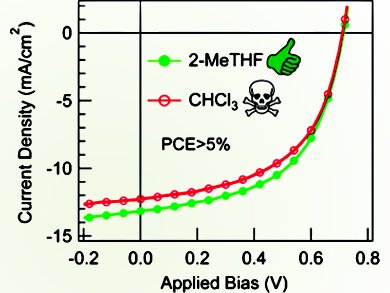Continuous improvements in the design of solar cells has resulted in increased efficiencies, however, bulk heterojunction (BHJ) solar cells are typically constructed using toxic chlorinated and/or aromatic solvents.
Guillermo C. Bazan and his team at the University of California, Santa Barbara, USA. have shown how BHJ solar cells can be fabricated using the more environmentally friendly solvent 2-methyltetrahydrofuran (2-MeTHF). It has a lower toxicity than common halogenated or aromatic solvents, and is obtained from furfural, which in turn can be derived from agricultural waste. The researchers used a molecular semiconductor donor and a fullerene-containing acceptor in the active layers of the device. Comparison of BHJ solar cells showed that devices constructed using 2-MeTHF (5.1 %) showed higher efficiencies than cells constructed using chloroform (4.7 %). Further experiments showed that the structural order of the blends formed from both chloroform and 2-MeTHF were similar.
In an attempt to understand which functional groups are most suitable for use with green solvents, experiments with other donor molecules bearing different side chains were carried out and it was found that molecules with polar side chains did not crystallize well from 2-MeTHF to provide the correct BHJ morphology.
This work provides an opportunity for eliminating halogenated or aromatic solvents from the mass production of solar cells.
- Green-Solvent-Processed Molecular Solar Cells
Xiaofen Chen, Xiaofeng Liu, Mark A. Burgers, Ye Huang, Guillermo C. Bazan
Angew. Chem. Int. Ed. 2014.
DOI: 10.1002/anie.201409208




